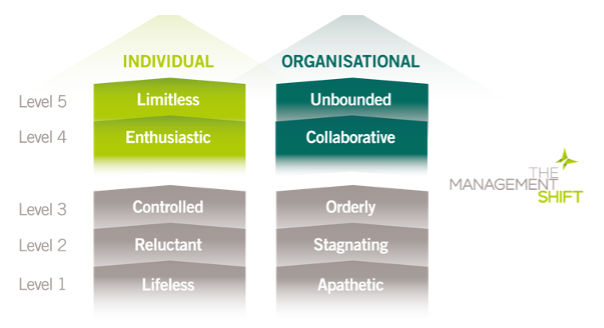Making the shift to a successful hybrid workplace demands a different leadership approach – one that moves away from micromanagement and towards a culture of trust and transparency, says Hult Professor, Vlatka Hlupic
The global economy has been left in a fragile state following lockdown measures, many of which have been prolonged at the time of writing this article, leaving further uncertainty on how businesses will recover. What is certain, however, is that business leaders and organisations must adapt and recalibrate to survive and thrive in the post-pandemic world and create high-performing hybrid workplaces.
Instead of a traditional top-down leadership approach based on command and control, hierarchical decision-making and micromanagement; high-performing hybrid workplaces will need a different leadership approach which is more shared and distributed. This type of leadership corresponds to levels four and five of a framework, called ‘The Management Shift’. In this framework, there are five levels of an individual mindset and a corresponding organisational culture at every level. Each level is characterised by specific thinking patterns, behaviour, language used, leadership style and organisational outcomes.

Five levels of overriding mindset and organisational culture
At level one, a dominant mindset is ‘lifeless’; culture is ‘apathetic’, based on fear and employees are isolated and disengaged. At level two, the individual mindset is ‘reluctant’; culture is ‘stagnating’ and people do the minimum they can get away with, just to get paid. There is a blame culture, and employees feel overwhelmed. At level three, the mindset is ‘controlled’ and culture is ‘orderly’. The leadership style is based on traditional command and control, employees are micromanaged, and they do what they are told to do, but they are not purposeful, fully engaged, or passionate for their work.
At level four, the dominant mindset becomes ‘enthusiastic’; culture is ‘collaborative’ and there is a strong teamwork ethos. Collaboration, integrity, purpose, transparency, accountability, and a caring culture are embedded in this level. This is also the level where a ‘Big Shift’ takes place and where highly engaged and inventive performance begins.
At level five, the mindset becomes ‘limitless’; culture is ‘unbounded’ and anything seems to be possible to achieve. This is where great innovations are developed and big problems for humanity are solved. However, this level can only be sustained for a limited time, as employees will ‘burn out’ if they work continually at this pace.
So how do leaders make the ‘Big Shift’ in their leadership styles to ensure their organisations are led in a way that gets the best out of their people in this new hybrid workplace?
Practices and behaviours that leaders should embrace
Leaders should support autonomy and collaboration and encourage experimentation with new ideas. They can influence employees indirectly through empowerment and inspiration, and create the conditions for change, where they delegate responsibilities, not tasks. Delegating tasks is micromanagement. When leaders delegate responsibilities, they show that they trust their employees to do their work well and employees will decide when, where and how they are going to do their work. They will be accountable for the deliverables – this is the key because, during a time of remote working, it is impossible to micromanage and control how and when the work gets done.
Leaders should also decentralise decision-making based on knowledge rather than a formal position in organisational hierarchy. People with the best knowledge, with the best insight into customer’s needs and requirements are best suited to make certain decisions, rather than somebody at the top of the hierarchy who doesn’t interact with customers.
Leaders need to develop cultures based on trust and transparency. This is particularly important for the hybrid world of work. It is vital to give a clear strategic direction for employees and communicate that well. That will create a sense of security and resilience, which will then also support the wellbeing of employees. Leaders also must support reward mechanisms that are based on contribution and meritocracy, especially as they cannot closely control employees that work remotely. They should focus on the results achieved, not on the time spent in the office or time spent at work.
Leaders need to use, and act, on feedback – and that should go both ways. In hybrid workplaces, feedback is even more important, not as a traditional yearly performance review, but rather as a continuous feedback conversation. Leaders should hone and use their social intelligence and emotional intelligence to get, and act on, the clues when something is not right even if employees are not directly sitting with them in the office all the time.
Successful leaders of hybrid workplaces allow some flexibility with procedures, rules and regulations, within reason. Even in heavily regulated and compliant environments, such as financial industry, there are still parts of the business that need to be creative. Here, leaders can relinquish control and allow employees to take their own initiative, make decisions and pursue some of their own initiatives for the benefit of an organisation, especially when innovation is important part of what organisation does. Without that, no progress and no innovation will emerge.
Leaders that embrace a level four mindset and behave like level four, and occasionally level five leaders, will create the conditions that are conducive to successful, highly productive and engaging hybrid workplaces.
To this end, it is important to allow people to work from home for at least half of the working week. At the same time, leaders should create office environments which entice people to spend some time there, interacting and networking. Human connections often lead to the creation of the best ideas.
Every change starts with one single step that creates ripples. What is one action that you can start implementing from next week to help create a high-performing hybrid workplace?
Vlatka Ariaana Hlupic is a Professor of Leadership and Management at Hult Ashridge Executive Education, Hult International Business School. She is the founder and CEO of the training, coaching and consultancy firm, Management Shift Solutions as well as the author of The Management Shift and Humane Capital.




























